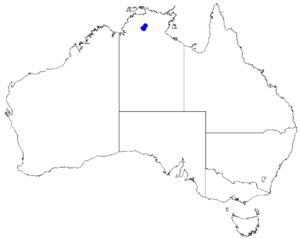Boronia tolerans facts for kids
Boronia tolerans is a special plant that belongs to the citrus family, called Rutaceae. It's only found in a small area of the Northern Territory in Australia. This plant is a bushy shrub that stands upright and has many branches. Its leaves are shaped like feathers, and its flowers are white with four petals. You can only find Boronia tolerans growing in Nitmiluk National Park.
Quick facts for kids Boronia tolerans |
|
|---|---|
| Scientific classification | |
 |
|
| Occurrence data from Australasian Virtual Herbarium |
Contents
What Does it Look Like?
Boronia tolerans is a bushy plant that stands upright. It can grow up to about 50 centimeters (about 20 inches) tall. Its leaves grow in pairs opposite each other on the stem.
Leaves
The leaves are shaped like a feather, which means they have smaller leaflets branching off a main stem. They attach directly to the plant without a stalk. Each leaf is usually between 7 and 50 millimeters long and 8 to 17 millimeters wide. The leaflet at the very end of the leaf is usually long and narrow, about 8 to 25 millimeters long and 1 to 2.5 millimeters wide. The side leaflets are a bit smaller, around 5 to 16 millimeters long and 1 to 2 millimeters wide.
Flowers
The flowers grow one by one where the leaves meet the stem. This spot is called an axil. Each flower sits on a tiny stalk, called a pedicel, which is about 1 to 2 millimeters long. The flowers have four sepals and four petals, and both are white. Sepals are like small leaves that protect the flower bud. These sepals are triangular or egg-shaped, about 4 to 5 millimeters long and 1.5 millimeters wide. They grow bigger as the fruit develops. The four petals are about 3.5 to 5 millimeters long and also get bigger as the fruit grows. Each flower has eight stamens, which are the parts that produce pollen. The top part of the flower, called the style, is smooth and hairless. Boronia tolerans usually blooms from March to June.
How it Got its Name
The plant Boronia tolerans was officially described in 1997 by a scientist named Marco F. Duretto. He wrote about it in a science journal called Nuytsia. The second part of its name, tolerans, comes from a Latin word meaning "tolerant." This name was chosen to remember a difficult day that Dr. Greg Howell experienced when he was collecting this plant in the field.
Where it Grows
This type of boronia plant grows in woodlands. You can find it on top of the high, flat land (called a plateau) within the Nitmiluk National Park.
Protecting the Plant
Boronia tolerans is currently classified as "near threatened." This means it's not in immediate danger, but it could become threatened in the future if its habitat isn't protected. The Territory Parks and Wildlife Conservation Act 2000 helps to protect plants like this in the Northern Territory.

